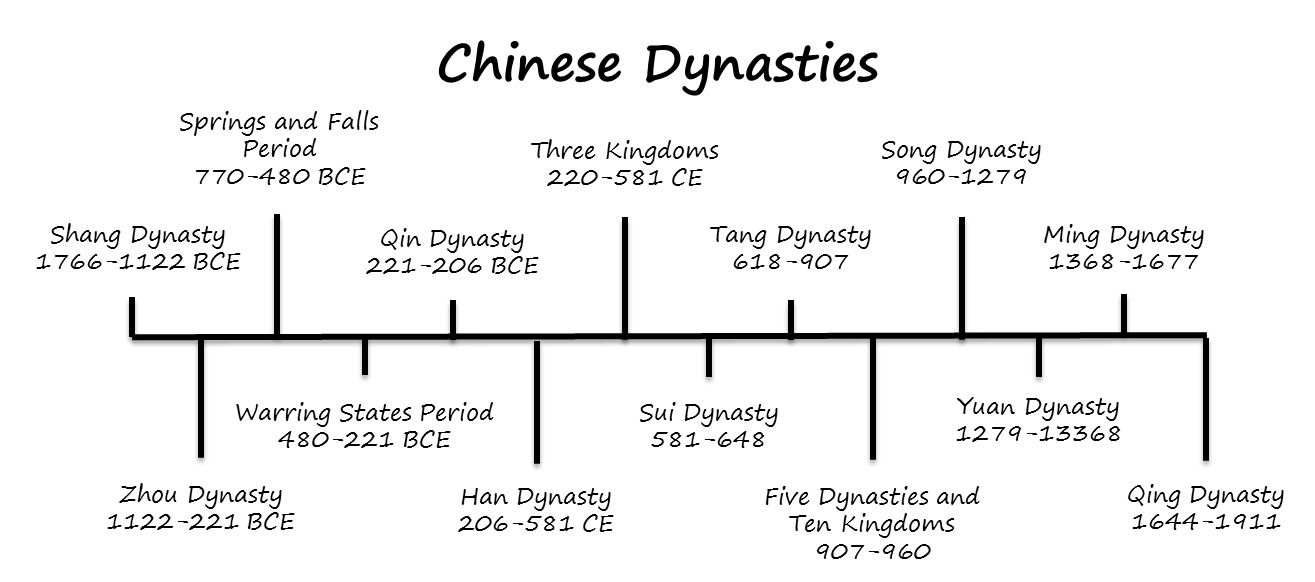These are not the entire list of dynasties in Chinese history(entire list is at the end of this article). However, I don't want you to memorize all of them. If you can roughly familiarize yourself with just these 7 dynasties and their timelines, it will be sufficient for our study of Traditional Chinese Medicine (TCM). As an additional tip, try to connect Western history events to each dynasty, which will give you a brief insight into when that dynasty existed. I've highlighted those 7 dynasties in red. Let's memorize them using this mnemonic:
- Happy - Han Dynasty (202 BC - 220 AD)
- Sloths - Sui Dynasty (581 - 618 AD)
- Travel - Tang Dynasty (618 - 907 AD)
- Slowly - Song Dynasty (960 - 1279 AD)
- Yearning - Yuan Dynasty (1271 - 1368 AD)
- Meditative - Ming Dynasty (1368 - 1644 AD)
- Quietness - Qing Dynasty (1644 - 1912 AD)
Practice reciting the sentence and associating the words with the respective dynasties to enhance your memorization.
Happy Sloths Travel Slowly, Yearning Meditative Quietness.
 | |
|
Han Dynasty (202 BC - 220 AD) - Roman Empire:
AHM: Start of acupuncture and herbal medicine, fundamentals, Shang Han Lun, Nei Jing
During the Han Dynasty, the Roman Empire was also at its height, reaching its greatest territorial extent under Emperor Trajan in 117 AD. This era saw significant developments in architecture, law, and the arts in the Western world.
Sui Dynasty (581 - 618 AD), Tang Dynasty (618 - 907 AD) - Spread of Islam:
AHM: Accumulation of clinical experience, Sun Simiao
The Sui Dynasty coincided with the early years of Islam. In 610 AD, the Prophet Muhammad received his first revelation, which marked the beginning of the Islamic faith. Over the next few decades, Islam rapidly spread across the Arabian Peninsula and beyond.
Song Dynasty (960 - 1279 AD) - Crusades:
AHM: Publication and organization of encyclopedia type of books
The Crusades, a series of religious wars between Christians and Muslims, took place during the Song Dynasty. These military campaigns aimed to recapture the Holy Land from Muslim control. The First Crusade began in 1096 and was followed by several other crusades over the next two centuries.
Yuan Dynasty (1271 - 1368 AD) - Mongolian Conquests:
AHM: Reform of medicine, Neo-Confucianism
The Yuan Dynasty was established by Kublai Khan, the grandson of Genghis Khan, and was a result of the Mongolian conquests across Asia and Europe. The Mongol Empire, which was the largest contiguous land empire in history, expanded rapidly under the leadership of Genghis Khan and his successors, paving the way for the formation of the Yuan Dynasty in China.
Ming Dynasty (1368 - 1644 AD) - The Renaissance and the Age of Exploration:
AHM: Publication and organization of encyclopedia type of books
In Europe, the Renaissance (14th to 17th century) was a period of cultural, artistic, political, and economic rebirth following the Middle Ages. People shifted their focus from the divine to the human, claiming that they needed to restore the virtues of ancient Greece. This era saw remarkable developments in art, architecture, literature, and science. The Age of Exploration (15th to 17th century) took place during the Renaissance and was characterized by European explorers and navigators embarking on numerous expeditions to map and discover new lands. Notable explorers like Christopher Columbus, Vasco da Gama, and Ferdinand Magellan made groundbreaking discoveries during this time.
Qing Dynasty (1644 - 1912 AD) - The Industrial Revolution:
AHM: Western influence, Wen Bing
The Industrial Revolution, which marked a major turning point in global history with significant technological advancements and the growth of industrial production, took place during the Qing Dynasty. This period of rapid industrialization began in Britain in the mid-18th century and later spread to other parts of the world, significantly altering economies and societies.

Continue : 18C to now in China, Japan and Korea
https://acupunctureherbalmedicine.blogspot.com/2023/04/dynasties-of-east-asian-countries-from.html